Table of contents
Performance date: 6 janvier 2014
Documentation date: 19 mars 2015
Version state
Valid
Validation date: 3 mai 2018
Executions dates of this version
- 6 janvier 2014,
Version documentalist
- laurenzi (Carlo.Laurenzi@ircam.fr)
Version realisation
- Serge Lemouton (Computer Music Designer)
- Carlo Laurenzi (Computer Music Designer)
- Jérémie Henrot (Sound engineer)
Upgrade Motivation
New Max 6 version - new design of the patch with added functionalities.
Major upgrade to Spat 4.
Handling of reverb parameters programmed using Antescofo.
Other version(s)
Detailed staff
- violon, violon II, alto, violoncelle
Electronic equipment list
Computer Music Equipment
-
1 MacBook Pro - Apple Laptops
(Apple)
2.6 Ghz Intel core i7 - 16Go DDR3 -
1 iPad - Tablets
(Apple)
to run MIRA dedicated application for mixing and triggering cues -
1 Max 6 - Max
(Cycling74)
v6.1.10 -
1 antescofo~ - External objects
(Ircam)
v0.53.71 -
1 Ircam Spat - Library
(Ircam)
v.4.6.7 -
1 Fireface 800 - Sound Board
(RME)
-
2 BCF 2000 - MIDI Mixer
(Behringer)
alternative to the iPad for mixing and triggering cues -
1 Pedal - Pedal
for triggering cues by foot, if preferred to triggering them on the ipad.
Audio Equipment
-
4 DPA 4060 - Condenser Microphones
(DPA)
or equivalent -
8 Loudspeaker - Loudspeakers
Work related information
Premiere
- 18 avril 1989, Italie, Milan, Società del Quartetto
- 11 avril 2002, Paris, Ircam, Espace de projection
Publisher :
- Ricordi
Realisation
- Serge Lemouton
Work length
- 22 mn
Useful links on Brahms
- Spirali pour quatuor à cordes projeté dans l'espace (1987-1988), 22mn
- Marco Stroppa
| File | Author(s) | Comment | |
|---|---|---|---|
| Download [1,8 Mio] | Patch Antescofo version | original antescofo version | |
| Download [1,2 Gio] | Patch Spat | original spat version | |
| Download [2,2 Mio] | Document Spirali.DOC.pdf | Marco Stroppa | Carlo Laurenzi |
| Download [3,7 Gio] | All-in-one Spirali.dmg | Carlo Laurenzi | Full package, including antescofo and Spat 4 |
Instructions
Audio Setup
4 microphone inputs from the string quartet’s microphones to the console
4 direct outputs or digital sends from the mixing console to the computer’s audio interface
6 output channels from the computer’s audio interface to the console (a configuration with 4 output channels is also available, for smaller venues)
Microphones : 4 microphones Dpa 4060 (or equivalent), clipped on the instruments, behind the bridge. No other aerian microphones are needed.
Sampling rate: 48KHz (standard), 96KHz (highly recommended).
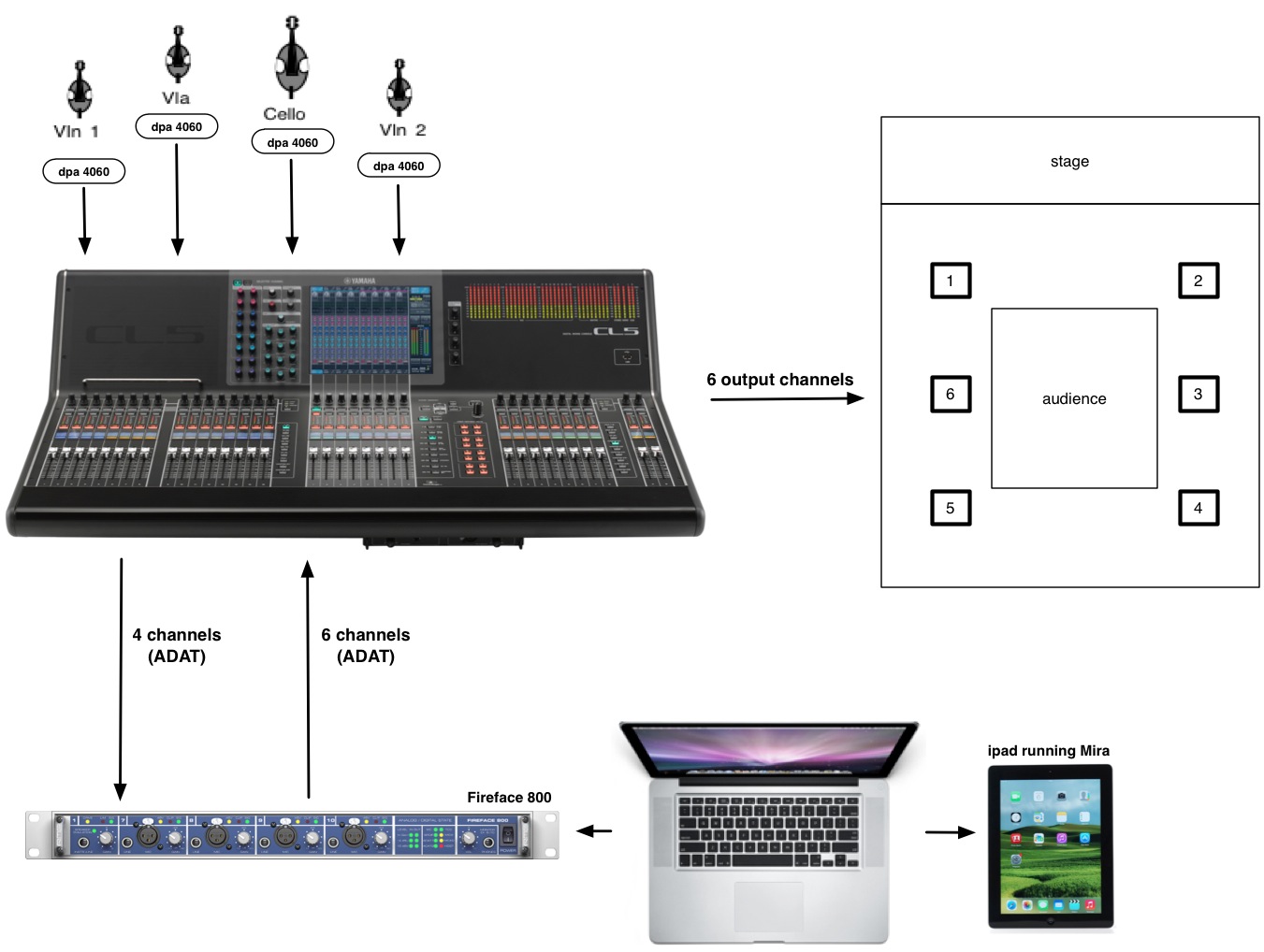

Loudspeakers setup
In the case of normal size, rectangular venues, the regular setup is made of 8 loudspeakers diffusing 6 independent output channels (see fig. 2). The couple of loudspeakers in 3 and 6 can be connected with a bridge (they provide both the same output channel).
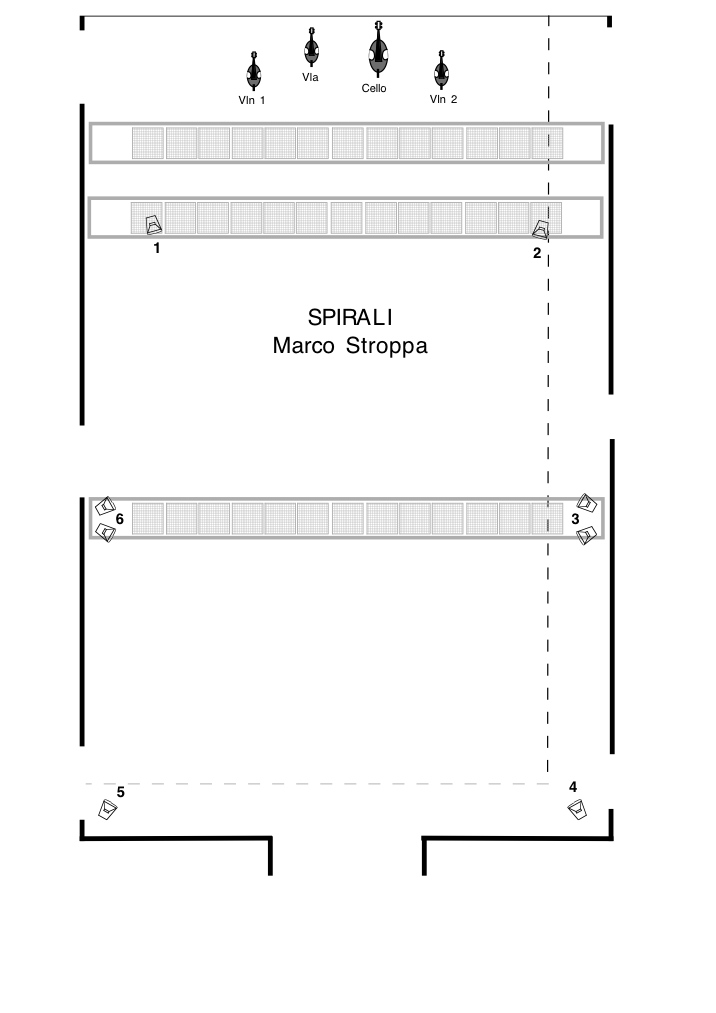
Fig. 2: Setup with 6 listening points and 8 wide-dispersion loudspeakers
In the case of smaller venues the recommended setup is made of 4 loudspeakers diffusing 4 independent output channels (see fig. 3 and 4)
4 wide-dispersion loudspeakers (one on each corner of the hall) with 4 independent listening points and amplification channels.

Fig. 3: Setup with 4 listening points and 4 wide-dispersion loudspeakers
In case of narrow-dispersion loudspeakers, each listening point should be doubled.

Fig. 4: Setup with 4 listening points and 8 narrow-dispersion loudspeakers
Remarks concerning the loudspeakers
1) The loudspeakers should be of excellent quality (such as, at the time when this document is written, d&b E12, Meyer Sound UPA, L-Acoustics 12XT or equivalent). The power, size and type of the loudspeakers should be adequate to the hall and previously discussed with the Computer Music Performer. If the loudspeakers are passive, the amplifiers should be placed outside the hall, or be totally silent.
2) The loudspeakers can be hung or placed on high stands (at least 3/4 m above the audience). It should be possible to rotate and tilt them. The Computer Music Performer should experimentally find the most appropriate height, orientation and tilt according to the acoustical characteristics and the possibilities of the hall.
3) Should the hall have one or more balconies, some loudspeakers might have to be doubled (and placed on the balcony/ies). This solution should be discussed between the Computer Music Performer and the Venue Stage or Technical Director.
4) Unless the loudspeakers are much smaller than those mentioned in 1) a sub-woofer is not needed.
Midi Setup
In case a MIDI mixer is used instead of the iPad, 13 faders are needed, so two chained Behringer BCF-2000 are recommended.
A MIDI Pedal for triggering cues by foot.
To chain together two Behringer BCF 2000, proceed as follows:
a. Connect one BCF with two MIDI cables to the other one (see Fig. 5, right). This BCF should be in the s_3 mode (standalone 3).
b. Connect the other BCF to the computer with a USB cable (see Fig. 5, left). This BCF should be in the u_4 mode (USB 4).
c. Connect the MIDI pedal to the BCF in u_4 mode..
d. Assign a different controller number to each fader and save this configuration into a preset (or choose a preset that does exactly so). Presets where the controller number is the same, and only the MIDI channel changes will not work in the patch of Spirali.

Software installation
Copy the folder Spirali_ Max6-2014on the hard disk. It contains the following data:
docs: several documentation files, including the Performance Instructions, and the only currently available CD recording of the work by the Arditti String Quartett. Hear it in order to have an idea of what the electronic effects might sound like.
lib: all the additional Max6 objects needed to run the patch, except the Ircam Spat®, version 4, and antescofo (which have to be placed in max6 / packages folder).
music_score: the latest score of Spirali, including the notation of the sound projection.
simulations: two 4-channel simulation files, with sampling rates of 48 and 96 KHz, 24bits. (A simulation is the recording of the inputs of the microphones during a concert or a rehearsal. The signal is therefore very similar to what the patch might receive, including additional noises, page turns, and breathing. Markers are provided at structural changes and for each event in the score.)
spirali_scores: the Antescofo score.
The main patches Spirali_4LSp_nn_MIRA and Spirali_6LSp_nn_MIRA (respectively, 4 and 6 channels), where “nn” corresponds to a version number.
Make sure that the latest antescofo~ (current version 20-02-2015) and SPAT (4.6.7) packages be already correctly installed in Max6/packages. If not, please install them.
Software initialization
Launch Max, and set the preferences path to folder Spirali_MAX6-2014
Set the preferences in Audio Status with the following values : I/O vector size 128, Signal vector size 128, Scheduler in overdrive on, Scheduler in overdrive on, audio interrupt off, Sampling Rate 96Khz (or 48 Khz).
quit max, then relaunch it, then Launch patch Spirali_6LSp_nn_MIRA.
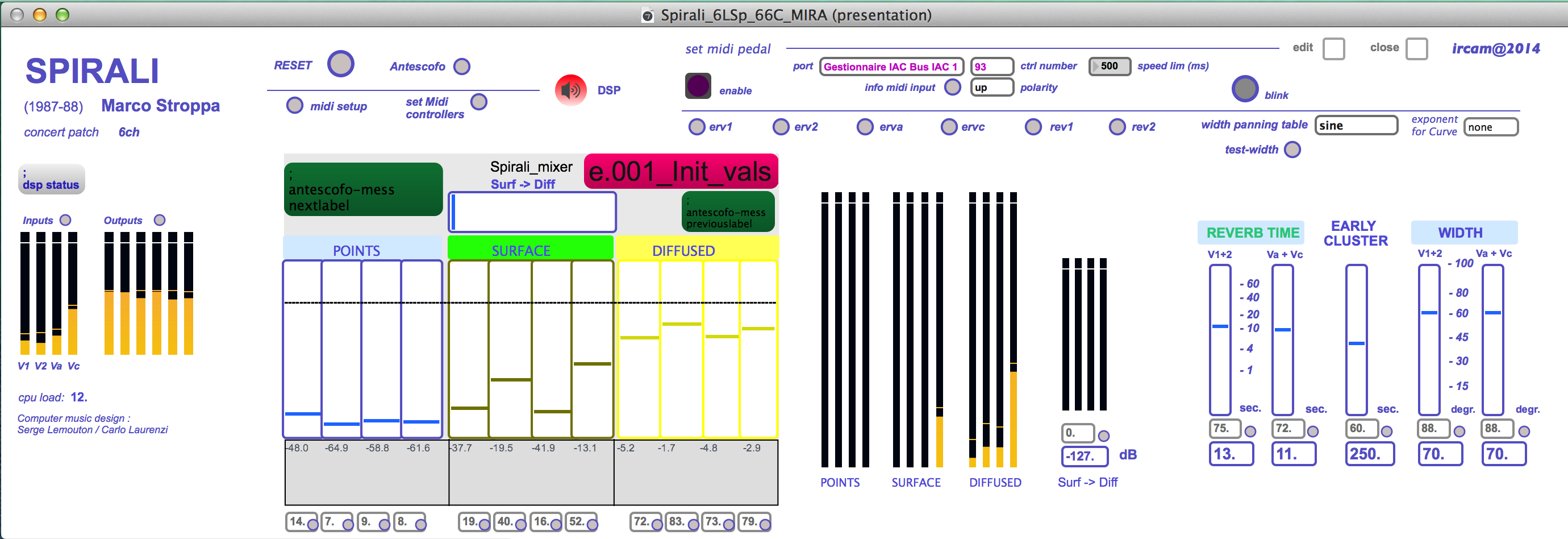

create an “ad hoc” network on the main computer, then connect the iPad to that “ad hoc” network. Verify that MIRA is connecting properly to that network. The MIRA virtual mixer panel should appear on screen. Verify if MIRA is correctly receiving and sending data.
press RESET (the patch is ready to be used for performing)
When using a midi mixer like BCF, click on « Midi controllers », move one fader at a time, notice its controller number and type it in the boxes below Direct / Early / Late and Early->late.

- At the end, save this preset (the first time, type a number in the box near store and click on store, then, after reopening the patch and this window, simply recall the stored preset). NB: Only the first 13 controllers are used. The others (from Rev Time to Width) are automatically controlled by Antescofo.
MIDI pedal initialization
Set the MIDI pedal directly on the main window: port, controller number and polarity. Once the pedal is correctly set up, click on enable and push it.
NB: speed lim (ms) corresponds to the minimum interval below which a second pedal stroke will not be recognized as a new action. This is typically used to avoid unwanted strokes.
Click on RESET () and proceed with the system calibration and tests.
System calibration and tests.
Space of POINTS / Main Loudspeakers
Click on test-width and activate the Source (Pink noise recommended), the Pulse, and Step Out1 from Chan. sending the pulsed signal to chan. 1 to 4.
Raise all the faders of POINTS (main window) to the same value and listen carefully that the pulses are balanced with each other (turn DSP on, of course!).

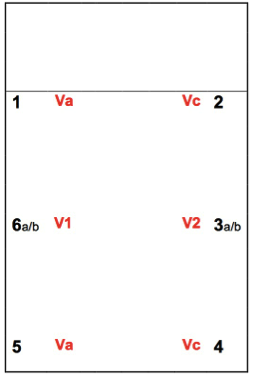
Fig. 9: Window for the test of the POINTS and the Width and loudspeakers for 6 POINTS
Change the position, orientation and/or tilt of the loudspeakers, or the level of the outputs in the mixing desk in order to achieve a perfectly balanced sound level across the hall.
When using the version with 4 loudspeakers, the panning corresponds to the loudspeakers 6, 3, 4, 5 (rear square), that is violins in the front, viola and cello in the rear.
Turn the POINTS’ faders down at the end.
Width and Panning curve test
This test aims at finding the smoothest panning for the SURFACE (early reflections + cluster) for the specific hall where Spirali is performed. When the width is 0, SURFACE is sent to the same loudspeakers as the POINTS. When it is 100, it is spread out to the adjacent loudspeakers as a stereo signal (SR/SL = surface left/right). There are two different, independent setups, one for V1 and V2, the other one for Va and Vc.
In the version with 6 loudspeakers, the following panning is used (from width = 0 to width = 100):

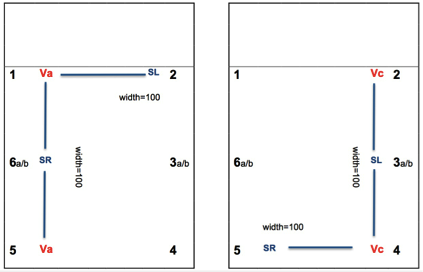
Fig. 10: Panning for width=100 (V1: 6à1, 3, 5; V2: 3à2, 4, 6 / Va: 1, 5à2, 6; Vc: 2, 4à3, 5)


In the same window as above (Fig. 9), send Pink noise to Chan. 1, raise the SURFACE fader of V1 and carefully listen to the smoothness of the transition when alternatively clicking on 0 and 100 below width couple. Proceed in the same way for the other instruments. Try also with a different early + cluster delay (default = 200ms).
Mid point.
Once the panning table is chosen, determine the “mid point”, that is the value of width where the signal has the same amplitude on all the loudspeakers (default = 50, which works for sine and linear). For a curve, it will depend on the exponent (Ex. exp: 0.5=48 / 1.5=62 / 1.8=65 / 2.0=67 / 2.5=70).
If the mid-point is not the default (50), open the Antescofo score (spirali_scores/1_spirali_6[4]LSp.asco.txt) and set this level as a value of the variable $W50.

fig 12 : Mid point for the width
Surface and Diffuse reverb time test (optional)
The time duration of the two families of spaces (surface [early reflections + cluster] and diffuse [reverb]) is assigned by functions written in the Antescofo score and marked in the score of Spirali under each event. The Surface and Diffuse spaces are defined by 9 functions:
S_vsh (very short), S_sh+ (between very short and short), S_sh (short), S_sh- (between short and medium), S_mid (medium), S_mid+ (between medium and long), S_lg (long), S_vlg (very long), S_max (the maximum value).
D_vsh (very short), D_sh (short), D_mid (medium), D_mid+ (between medium and long), D_lg (long), D_lg+ (between long and very long), D_vlg (very long), D_vlg+ (extremely long), D_max (maximum duration).
Each function has a base duration and an argument. The base duration is a global value that applies throughout the piece, the argument is a value that is locally added or subtracted to the global one. Ex:

fig 13 : local time difference (argument) for the Middle diffuse space
The values written in the Antescofo score will work in most cases. However, if the concert hall has an unusual acoustics (for instance, a church), it is recommended that they be adapted to these extreme conditions. Open the Antescofo score and type in the new values, either globally (in the body of the functions) or locally (as an argument to the function in each action).
Input levels test (only with the string quartet)
Before rehearsing with the string quartet, the input signals should be carefully balanced and equalised in the mixing desk. In spite of the very close microphones, make sure that each instrument sounds correct, and is perfectly balanced with the others, that is, that the same level of each fader of the POINTS gives the same loudness. Spend enough time for this task, since it will determine the quality and ergonomics of the sound projection during the concert.
Patch presentation


Once the patch has been initialized and calibrated, type RESET () again, and look in the Max window that everything is correct. There is no need to calibrate the patch again (for the same concert), but it should be initialized each time Max is started.
During the concert, only the main and the Antescofo windows are needed. Select the correct score in the Antescofo window (1_spirali_6LSp.asco.txt or 1_spirali_4LSp.asco.txt) and press either or the MIDI pedal. This will load the first action and display the label e.001_Init_vals.
From experience, it is more practical to advance each new event with the pedal. This leaves the hands on the MIDI mixing desk and improves their reactivity.
When using the simulation, choose the file that corresponds to the current sampling rate, and simply start from the beginning or from one of the events in the pop up menu. Set a PREROLL (ms) if needed.
For more details about the performance, see the chapter below.
Performance Instructions
Reference level of the amplification (N)
Ideally, the acoustic string quartet should not be audible by the audience (or be as soft as possible), and only the amplified sound is to be perceived. The level of the amplification should not distort the timbre of each instrument, but be loud enough to clearly cover the acoustic sound. From experience, a level 20 to 30 dB higher than the acoustic sound is normal. In large halls, it is definitely larger.
This level is marked as N (Normal level of the amplification) in the score. Since it depends on the played dynamics, it is not an absolute intensity, but it should give the perception of a clearly amplified, yet homogeneous string quartet with a balanced timbre projected around the audience.
At the beginning of the rehearsal, this level should be experimentally determined. The first “Rapidissimo” is a good place where to carefully listen for both the balance between the strings and the N level.
Other amplification levels
There are five other amplification levels for the spaces, which are notated relative to N:
a. - -: clearly below N, barely perceptible
b. -: clearly perceptible, but lower than N
c. +: clearly above N, but not exaggeratedly louder than N
d. ++: macro-amplification (especially used for soft dynamics that have to be abnormally amplified)
e. Mx: extreme macro-amplification (same as ++, but as much as possible; beware of feedback!)
Notation of the events’ labels and parameters
The events have a label called e.[.][_], where: is a three-digit measure number (ex. e.001), an integer number starting from 1, which corresponds to the 1st event of that measure (if there are more than one, ex. e.254.2), and are optional comments, preceded by “_” (ex. e.045_Wloop). Comments are not notated in the score (fig. ).
Events are written into a rectangle box. Near the box are placed the five automatized parameters: T1 = reverb time (Diffuse space) for V1 and V2, T2 = reverb time (Diffuse space) for Va and Vc; Cl = Cluster Time (Surface) for all the instruments; W1 = width for V1 and V2, W2 = width for Va and Vc.
When the parameters are notated below the box, they correspond to actions or processes that immediately perceptible (Fig. 14, left). When they are notated near the right side, they mean that some values are being prepared for a later usage (Fig. 14, right).


Fig. 14: Parameter notation, left = immediate action, right = used later
Times are indicated symbolically (ex. vlg, see 2.3, c). If an argument is given, it indicates a value that is added or subtracted to the main symbolic value.
The width is indicated with a number between 0 and 100.
The time needed to reach the given value is marked within brackets only when it is long. In this case, it is preceded by “” (ex: W0 [18”], reach width=0 in 18”, Fig. 14, left). Short times, used to avoid clicks, are not marked and the parameter’s value is preceded by “=” (ex: W=55, set width to 55 in a short time, Fig. 14, right).
Cyclic changes of times or widths are indicated only approximately (slow, fast, very fast, etc.), but the extreme values are precisely notated as an argument with two values separated by a “/” (ex. W1(0/100) fast, cyclically move W1 between 0 and 100 rapidly).
When an arrow is marked above the left side of the rectangle, this means that the event should be cued VERY precisely, that is, it must be synchronous with the score (fig. ). Without an arrow, there is a margin of error (as the values being prepared will used only later, fig. ).
Notation of the three spatial families
P, S or D are marked in a square and refer to the spaces of Points, Surface and Diffuse. A further space (used only once, b. 91-110) is SD,meaning that the output of the Surface will be directed into the Diffuse space.
While a spatial family is active, a horizontal line continues the lower side of the square, until that family is no longer used.
Above this line, crescendi and diminuendi are notated, which corresponds to movements of the main 13 faders. If an instrument is given, only the fader corresponding to that instrument is concerned (Fig. 15).

Fig. 15: Local dynamic change, different for each instrument
When no instruments are marked, all the faders of a give space should be moved (Fig. 16).

Fig. 16: Global dynamic change, the same for all the instruments
Delicate moments
M. 2: Create a sound coming from nowhere. The level of the amplification should be quite strong, however, without producing the impression that it is too loud. The atmosphere remains intimate and mysterious.
M. 3: It is not easy to perceive the beginning of this measure (change of notes in Va and Vc). Ask the string quartet to give a sign. The B’s must produce the result of a sound gradually emerging from the diffused space.
M. 6: The cue for the event is the Eb in the Va. The acoustic feeling of this second space should be precisely balanced with the beginning, neither too loud, nor too soft, still intimate. Simple a change of spatial feeling.
M. 11: In all the quick changes of spaces, from S to P, raise the P before very rapidly fading the S out, in order to avoid a hole in the amplification.
M. 20: Precisely fade V1/S and V2/S out during the glissando of the Vc, so that their pizz. comes only through the P.
M. 61: The variation between P and S should be quite slow, and, especially, follow the music. Here it generates a change of focus, S being equally spread across the main and the left/right loudspeaker, P being diffused only from the main one.
M. 91-110: The most processed sound of Spirali. Extremely far and diffused space, quite loud. Cue for the event at b. 96: V1, D6; cue for the event at b. 103: Vc, G4.
M. 136-7 / 157-157-60: Difficult to synchronize, be careful in sending enough sound to the D space.
M. 189-199: Difficult to isolate the figures with P.
M. 203-214: Be very precise in separating the passages sent to D from the others. It is a sort of spatial hoquetus.
M. 255: Very tricky to pick up the sounds to be sent to D.
M. 262-4: Also quite hard to synchronise.
M. 275-357: In all this final Rapidissimo the space should be extremely mobile and the balance between P and S constantly changed. When the inner space of the string quartet (passage of one figure from one instrument to another) is clearly perceptible, P should prevail. S varies rapidly between 0 and 100, and therefore generates a very unstable spatial perception for each instrument.
M. : It is not easy to pick up the figures with P.
M. 379-404: Very important moment, two superposed spaces, V1/V2 extremely far, and Va/Vc closer, but still a little unreal. Create a magic feeling!
End: As much and as long reverb as possible (almost infinite, current value: 80s, but it can be increased in the Antescofo score), as if the sound of the quartet would indefinitely continue after the players have stopped playing.
© IRCAM

This documentation is licensed under a Creative Commons Attribution-NonCommercial-NoDerivatives 4.0 International License.
Version documentation creation date: 11 décembre 2013 10:57, update date: 24 mars 2021 15:01